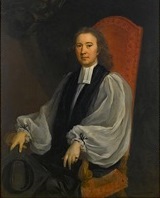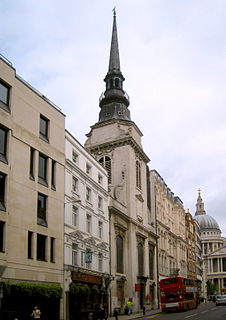
Richard Willis (1664–1734) was an English bishop.
Richard Yeo RA was a British medalist and Chief Engraver at the Royal Mint, in which capacity he supplied patterns for the guinea and five guinea coins of George III. He was a founding member of the Royal Academy of Art, and appears in the group portrait by John Zoffany.
Adam of Barking, was a Benedictine monk and religious poet who left a number of writings including De Serie Sex Ætatum which runs to 15,000 lines of hexameter. He belonged to the abbey of Sherborne in Dorset.
The Library of Anglo-Catholic Theology was a series of 19th-century editions of theological works by writers in the Church of England, devoted as the title suggests to significant Anglo-Catholic figures. It brought back into print a number of works from the 17th century, concentrating though not exclusively on the Caroline Divines. The publication of the Library, from 1841, was connected with the Oxford Movement which had begun in 1833; some of the editors, such as William John Copeland and Charles Crawley were clearly identified with the Movement. However the interests of the Library diverged early from those of the Tractarians. A total of 95 volumes by 20 writers was published over a dozen years; the plan, originally, had been to include 53 authors.
The Lord President of Connaught was a military leader with wide-ranging powers, reaching into the civil sphere, in the English government of Connaught in Ireland, in the sixteenth and seventeenth centuries. The office was created in 1569, and in 1604 was reconstituted with full powers to hear all civil suits, to impose martial law and to proceed with "fire and sword" against the King's enemies. The width of his powers gave rise to clashes with the longer established courts: in 1622 he and the Lord President of Munster were ordered not to "intermeddle' in cases which were properly within the remit of those courts. He was assisted by a council whose members included the Chief Justice of Connacht, one or two associate justices and the Attorney General for the Province. The office was abolished in 1672.
John Shepreve (1509?–1542) was an English classical scholar and Hebraist.
The Tracts for the Times were a series of 90 theological publications, varying in length from a few pages to book-length, produced by members of the English Oxford Movement, an Anglo-Catholic revival group, from 1833 to 1841. There were about a dozen authors, including Oxford Movement leaders John Keble, John Henry Newman and Edward Bouverie Pusey, with Newman taking the initiative in the series, and making the largest contribution. With the wide distribution associated with the tract form, and a price in pennies, the Tracts succeeded in drawing attention to the views of the Oxford Movement on points of doctrine, but also to its overall approach, to the extent that Tractarian became a synonym for supporter of the movement.
John Bramis or Bromis was an English Augustinian friar and writer.
John Bridges (1666–1724) was an English lawyer, antiquarian and topographer.
The Socinian controversy in the Church of England was a theological argument on christology carried out by English theologians for around a decade from 1687. Positions that had remained largely dormant since the death in 1662 of John Biddle, an early Unitarian, were revived and discussed, in pamphlet literature.
Barvitus was a supposed Scottish saint. David E. Thornton suggests that he is a manifestation of the cult of St Findbarr, from north-east Ulster. Barvitus is said to have been the disciple of St Brandan, and his companion in his wanderings.
Henry Thomas Riley (1816–1878) was an English translator, lexicographer, and antiquary.
Augustine Bernher was a priest in England.
Anthony Hall was an English clergyman, academic and antiquary.
David Elisha Davy (1769–1851) was an English antiquary and collector from Suffolk.
Benedict of Gloucester was an English hagiographer, author of a life of St. Dubricius, mythological archbishop of Caerleon.





